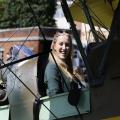IN 1940, a new home defence force was established.
Peter Salcombe of Oxfordshire Home Guard explains how the force protected Bicester during the Second World War
AT first called the Local Defence Volunteers (Winston Churchill later had it renamed the Home Guard), this new force followed a long tradition.
In previous centuries, there had been the militia units, formed to defend the country from invasion by the French and to free up regular units for service overseas.
They were however, very often, simply an opportunity for the landed gentry to dress in military style uniforms and play at soldiers.
These units were later replaced by the properly organised and trained territorial army.
At the outbreak of war, however, the territorial battalions were mobilised, and some people felt that this left a gap in our defences.
A few retired officers from the First World War, formed their own groups to patrol the countryside looking for spies and saboteurs.
Very often, they drew their members from shooting clubs and country associations (a cavalry unit from the local hunt, for instance).
Not surprisingly, the Government was not too happy with armed bands of civilians roaming the countryside.
These small private armies tended to disappear during the so called phoney war, but with the German invasion of the Low Countries on May 10th, rumours of German paratroops and fifth columnists began to spread.
Winston Churchill, at that time First Lord of the Admiralty, called for the establishment of an official Home Guard to patrol local areas.
This was also, in part, to prevent the formation of private groups, especially since communist veterans of the Spanish civil war, wanted to train volunteers in guerilla tactics, which it was feared, might be used against the government.
On May 14, 1940, Anthony Eden, Secretary of State for War, announced the formation of the LDV, but did not use the name Home Guard, which was preferred by Churchill.
Originally, Oxfordshire was a single battalion, divided into seven companies, one of which was Bicester.
However, it was soon realised that the number of recruits far exceeded expectations and these companies were soon designated as battalions.
2nd Battalion Oxfordshire was the Bicester Battalion with more than 1,600 men.
By 1941, this consisted of four companies, Bicester itself, Deddington, Kidlington and Woodstock.
The Bicester Company included platoons from Fringford, Launton, Heyford, Stratton Audley and of course, Bicester itself.
The Oxfordshire Home Guard and Home Front Living History Group formed about four years ago by a small group of enthusiasts, we now have more than 40 members who put on displays and give talks around the Bicester area and beyond.
The group is run by its members, with decisions taken at twice monthly meetings held at Launton Parish Hall.
Because of this, we have named ourselves the Launton Platoon of the 2nd (Bicester) Battalion, Home Guard.
'Dad's Army' was a great television series, but we want people to realise that the real Home Guard was made up of men (and some women) who were prepared to fight to defend this country at a time when invasion was a real possibility.
Most people do not realise that the Home Guard did actually engage the enemy.
They manned anti aircraft guns and shore batteries.
A number of its members were killed whilst on duty, including two who were awarded the George Cross for their bravery.
For more information on our group, go to oxfordshirehomeguard.uk







Comments: Our rules
We want our comments to be a lively and valuable part of our community - a place where readers can debate and engage with the most important local issues. The ability to comment on our stories is a privilege, not a right, however, and that privilege may be withdrawn if it is abused or misused.
Please report any comments that break our rules.
Read the rules here